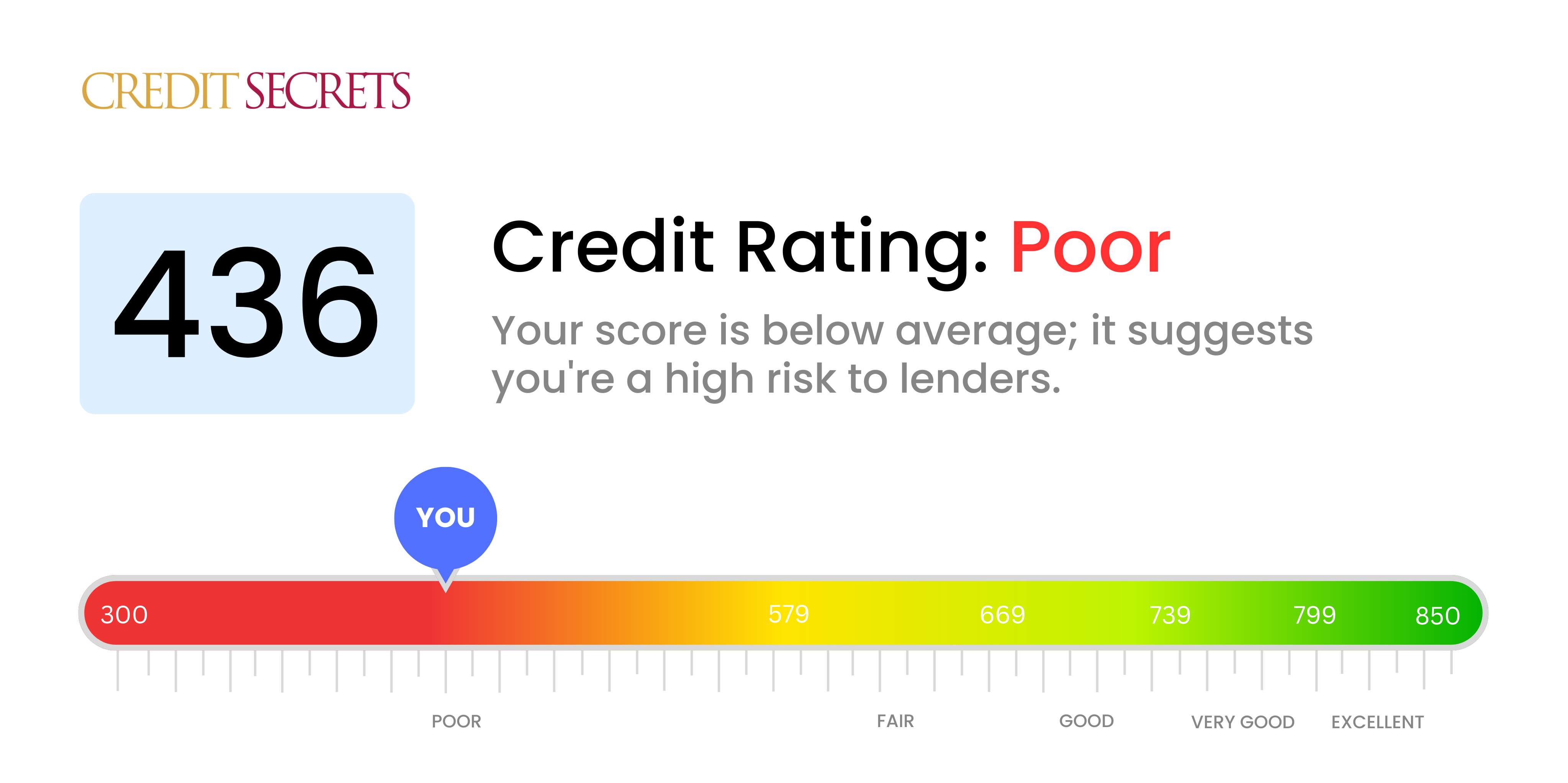Is 436 a good credit score?
Facing a credit score of 436 can feel daunting, but there is room for improvement. With this score, you fall into the 'Poor' category, implying you might have had past issues like defaulted loans, late payments, or public records such as bankruptcy. It could present challenges in getting approved for credit cards or loans, but know that you do have the ability to improve it.
Changing your credit score may require time, patience, and smart decisions. You might face higher interest rates or stricter conditions when applying for loans. However, with smart financial habits such as paying bills on time, reducing your debt, and carefully managing your credit cards, you can start on your journey towards better credit health. Remember, small steps can add up to a significant impact over time.

Can I Get a Mortgage with a 436 Credit Score?
Unfortunately, with a credit score of 436, you are not likely to be approved for a mortgage. Lenders typically look for a score above 620 as it represents a lower risk of loan defaults. A credit score as low as yours suggests that you've faced some financial burdens, such as missed or late payments, or have had some troubles with managing your credit.
However, all is not lost. There are several steps you can take to begin improving your score. One of the most important things you can do is to become current on any past-due balances or delinquencies that may be affecting your score. Over time, as you create a habit of prompt payments and careful credit use, your credit score will start to improve. Admittedly, it's going to be a journey, but with dedication and financial diligence, you are fully capable of turning your credit around towards a healthier future.
Still, while you are working to improve your credit score, you might want to consider alternatives to traditional mortgages, such as joining a credit union, saving for a larger down payment, or exploring government-backed mortgage programs, which may have less stringent requirements. Even if your credit score doesn't allow for a mortgage right now, it doesn't mean you're permanently barred from homeownership.
Can I Get a Credit Card with a 436 Credit Score?
With a credit score of 436, securing approval for a traditional credit card may prove to be a significant obstacle. This score is often seen as risky by lenders, indicating a rugged financial past or difficulties maintaining on-time payments. It's worth understating how confronting these realities, tough as they might be, constitutes an essential stepping-stone on the road to financial recovery. Knowledge is power, after all, and understanding your current credit status marks a crucial first step in a longer journey towards financial stability.
Given the challenges posed by a low score such as 436, you might find it beneficial to explore alternatives. Opting for secured credit cards, whereby a deposit is made to establish your credit limit, could be a prudent choice. These cards can be less challenging to acquire and can help elevate your credit score over time. Other alternatives include seeking a trustworthy co-signer or considering pre-paid debit cards. Though not an immediate remedy, these options can prove instrumental in shaping your financial future. Keep in mind, though, that interest rates for any form of credit accessible with such scores are likely to be considerably higher, mirroring the increased risk for lenders.
Having a score of 453, your credit situation is currently challenging. This score is much lower than what typical lenders find acceptable when considering personal loan applications. So, typically, you would have a slim chance of securing a loan. However, remember this is not the end of the road, and there are other paths you can explore.
Options like secured loans, where you back your loan with collateral, or co-signed loans, where a trustworthy person with good credit supports your application, could be potential alternatives. Another possibility might be peer-to-peer lending platforms, as they sometimes have more flexible credit requirements. Please be aware, though, that with these loan types, higher interest rates and less friendly terms are common due to the elevated risk to the lender. However, they may help when traditional loans are not an option.
Can I Get a Car Loan with a 436 Credit Score?
With a credit score of 436, it would be tough to get approval for a car loan. Car loan lenders typically seek scores above 660 for better lending terms. Your score, unfortunately, falls well below this range. Given that any score below 600 is often considered subprime, you may face issues such as higher interest rates or even outright denial of your loan application. This is because lenders view a lower credit score as an indication of increased risk, suggesting that you might have difficulties in repaying the borrowed money.
This isn't a total roadblock in your journey to acquire a car though. There exist lenders who focus on assisting those with low credit scores, like yours. Keep in mind, however, that loans from such lenders usually come with much higher interest rates. This increased interest is due to the perceived risk that the lenders believe they are taking. It is a way for them to protect their investment. With careful planning and a deep understanding of the terms, there's still a chance for you to secure a car loan. Remember to tread carefully, your financial well-being should always be your top priority.
What Factors Most Impact a 436 Credit Score?
Knowing the implications of a 436 credit score is the first step towards better financial health. Addressing factors related to this score cannot only increase your score but also provide a strong financial footing. Each financial journey is special with endless learning options.
Mismanaged Payments
Your payment history exerts a heavy influence on your credit score. Missed or late payments could be one of the main reasons for your score.
How to Check: Inspect your credit report for any late or missed payments. Think about periods when you were unable to make timely payments as this could be affecting your score negatively.
High Use of Credit
Over utilisation of your credit limits could be a detrimental factor to your score. Your credit score could be low if you are consistently close to or at your credit limits.
How to Check: Look at your credit card statements. Are you utilizing high percentages of your available credit? Striving to keep your balances low in relation to your limits can help your score.
Short Credit History
A short length of credit history can lower your score. Your score might be lower because you don't have a long history of managing credit.
How to Check: Consider the age of your credit accounts. Check your report to see the age of your oldest and newest accounts, and the average age of all your accounts. Think about any new accounts you may have opened recently.
Credit Variety
Holding various types of credit and managing them correctly contributes to a higher score. If you only have one type of credit, it may be lowering your score.
How to Check: Observe your existing credit types. Ensure your portfolio is diversified, with credit cards, retail accounts, installment loans, and mortgage loans.
Legal Judgments
Legal actions such as bankruptcies or tax liens can significantly lower your score.
How to Check: Review your credit report for legal judgments. It's important to resolve any issue that may be present in order to improve your score.
How Do I Improve my 436 Credit Score?
With a credit score of 436, you’re certainly in a tough spot, but remember, there’s a course of action for every score. Here’s a clear action plan designed just for you:
1. Manage Your Charge-offs & Collections
At this score level, there’s a possibility that you have charged-off accounts and collections. Aim to pay off these debts as soon as possible. Reach out to the creditors, discuss your situation, and ensure an understanding for repayment.
2. Re-establish Credit with a Secured Credit Card
Being accepted for a traditional credit card could be challenging with your current score, making secured credit cards a viable option. These cards require a cash deposit, which will serve as your credit limit. This can start your journey to rebuild your credit history.
3. Examine Your Credit Utilization
Your credit score might be impacted by a high credit utilization ratio, which is the balance of your credit card compared to the credit limit. Try to keep your credit utilization ratio under 30%, prioritizing the most overutilized cards.
4. Consider Being an Authorized User
If you ask a reliable friend or family member with a stronger credit score to add you as an authorized user on their credit card, this can help boost your score.
5. Build a Variety of Credit
Once you’ve made progress with the secured card and regular payments, diversifying your credit could be beneficial. For instance, a small installment loan that’s managed responsibly can illustrate your trustworthiness to future lenders.
